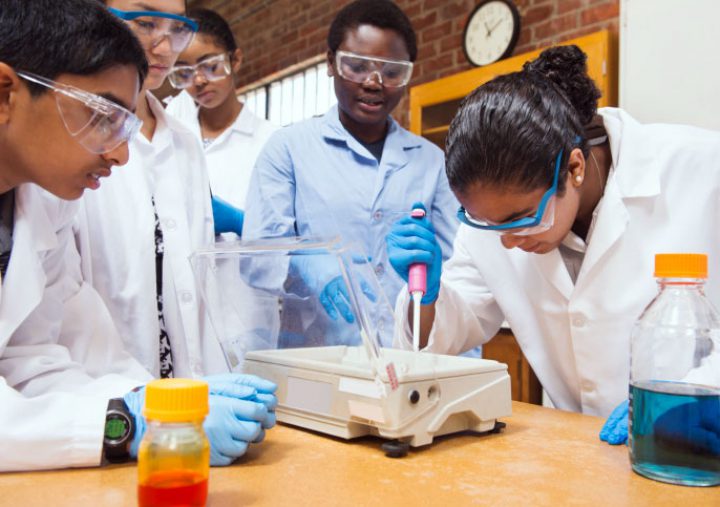Why focus on science and engineering practices--and not "inquiry?" Why is "the scientific method" mistaken?

- Teachers should review their curricula to look for ways the practices could be incorporated or emphasized to expand opportunities for students to learn and apply science concepts.
- District staff & PD providers should help teachers learn about the practices in ways that are relevant to instruction and relate to other local initiatives.
- School leaders should learn about the science and engineering practices, what practice-focused instruction looks like, and how practices are integrated into the three-dimensional view of learning.
What is the Issue?
For decades science education has engaged students in a version of science inquiry that reduces the investigation of the natural world to a fixed, linear set of steps—sometimes devoid of a deep focus on learning and applying science concepts. Rigid representations of a single "scientific method" do not accurately reflect the complex thinking or work of scientists. The new vision calls for engaging students in multifaceted science and engineering practices in more complex, relevant, and authentic ways as they conduct investigations.
Authors:
RICH BACOLOR, TANA PETERMAN, JEANNE CHOWNING & PHILIP BELL | JAN. 2015
Reflection Questions
- Where are the science and engineering practices already in your instruction? Also, think about how the practices can relate to each other in different ways to support science investigations. How might you build on or adapt your instruction accordingly?
- Which practices do your students have experience with outside the classroom? How might you leverage that?
- Watch, read about, and discuss how science works.
Things to Consider
- Science and engineering practices are the focus, not "inquiry" or the "scientific method." The NRC Framework reframes doing science "inquiry" to engaging in sequences of the eight core practices of science and engineering. While some of these practices overlap with aspects of "inquiry" or the "scientific method," overall they represent a more complete, holistic, and accurate view of scientific activity. "Inquiry" came to refer to too many different approaches—and content and process were often taught separately.
- Practices are multifaceted and progress over time. The everyday meaning of "practice"—i.e., repetitively doing a specific skill—is not what is intended. The "use of the term 'practices' instead of 'skills' emphasizes that engaging in scientific investigation requires not only skill but also knowledge that is specific to each practice." For each practice, different facets of it are detailed. Each practice also grows in complexity and sophistication across the grades. Students across K-12 should engage in all eight practices.
- Practices are a dynamic set of "building blocks" for student investigations. The practices are not different activities to do in isolation. They are not a linear set of instructional steps to follow repeatedly. The goal is for students to develop expertise in using appropriate practices to conduct their investigations, support their learning, and demonstrate their understanding. Engaging with a range of practices in different configurations helps students understand that there is not just one way to conduct science and that scientists draw upon varied practices in their research.
"The notion that there is a single scientific method of observation, hypothesis, deduction, and conclusion—a myth perpetuated to this day by many textbooks—is fundamentally wrong. Scientists do use deductive reasoning, but they also search for patterns, classify different objects, make generalizations from repeated observations, and engage in a process of making inferences as to what might be the best explanation. Thus the picture of scientific reasoning is richer, more complex, and more diverse than the image of a linear and unitary scientific method would suggest."
Attending to Equity
- The "scientific method" makes science into a series of rigid steps— and can lead students to disengage. In contrast, practices highlight how science is a highly social, creative, and iterative problem solving process involving a variety of different kinds of intellectual work.
- Engaging students in the practices can support important cognitive, social, and cultural learning processes. The practices also provide opportunities to draw upon the many ways that young people and communities make sense of the natural world.
Recommended Actions You Can Take
Learn about each of the science and engineering practices—one at a time. Read the NRC Framework and NSTA articles. Watch the Bozeman overviews and NSTA webinars. Learn about how each practice relates to science and engineering, the different facets of each for your grade band, and Common Core connections.
ALSO SEE STEM TEACHING TOOLS
STEM Teaching Tools content copyright 2014-22 UW Institute for Science + Math Education. All rights reserved.
This site is primarily funded by the National Science Foundation (NSF) through Award #1920249 (previously through Awards #1238253 and #1854059). Opinions expressed are not those of any funding agency.
Work is licensed under a Creative Commons Attribution-ShareAlike 4.0 Unported License. Others may adapt with attribution. Funded by the National Science Foundation (NSF). Opinions expressed are not those of any funding agency.


 Email Feedback
Email Feedback


